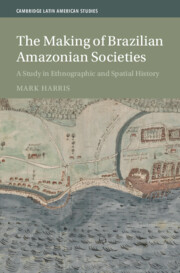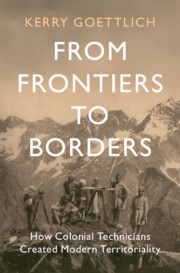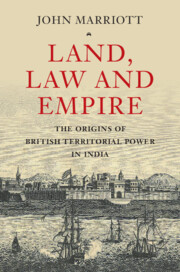Refine search
Actions for selected content:
363 results
4 - The Making of the Sertão
-
- Book:
- The Making of Brazilian Amazonian Societies
- Published online:
- 14 November 2025
- Print publication:
- 20 November 2025, pp 133-165
-
- Chapter
- Export citation

The Making of Brazilian Amazonian Societies
- A Study in Ethnographic and Spatial History
-
- Published online:
- 14 November 2025
- Print publication:
- 20 November 2025

From Frontiers to Borders
- How Colonial Technicians Created Modern Territoriality
-
- Published online:
- 23 October 2025
- Print publication:
- 06 November 2025
Sovereignty in Cyberspace from the Viewpoint of International Law
-
- Journal:
- Asian Journal of International Law , First View
- Published online by Cambridge University Press:
- 22 October 2025, pp. 1-31
-
- Article
- Export citation

Land, Law and Empire
- The Origins of British Territorial Power in India
-
- Published online:
- 01 September 2025
- Print publication:
- 07 August 2025
Perspectives
-
- Book:
- Land, Law and Empire
- Published online:
- 01 September 2025
- Print publication:
- 07 August 2025, pp 1-8
-
- Chapter
- Export citation
1 - Tudor State, Chartered Companies and Colonization
-
- Book:
- Land, Law and Empire
- Published online:
- 01 September 2025
- Print publication:
- 07 August 2025, pp 9-34
-
- Chapter
- Export citation
8 - Extraterritoriality
- from Part II - Merits
-
-
- Book:
- The Cambridge Handbook on Climate Litigation
- Published online:
- 03 June 2025
- Print publication:
- 31 July 2025, pp 200-222
-
- Chapter
-
- You have access
- Open access
- HTML
- Export citation
Chapter 6 - Sovereignty over territory
-
- Book:
- International Law
- Published online:
- 26 July 2025
- Print publication:
- 31 July 2025, pp 303-335
-
- Chapter
- Export citation
1 - Frontiers
- from Part I - Practices of Space
-
- Book:
- Fractured Pasts in Lake Kivu’s Borderlands
- Published online:
- 17 July 2025
- Print publication:
- 31 July 2025, pp 51-84
-
- Chapter
- Export citation
8 - Colonies and Mandates
-
-
- Book:
- The Cambridge History of International Law
- Published online:
- 01 May 2025
- Print publication:
- 29 May 2025, pp 224-256
-
- Chapter
- Export citation
6 - Sovereignty, Territory and Jurisdiction
-
-
- Book:
- The Cambridge History of International Law
- Published online:
- 01 May 2025
- Print publication:
- 29 May 2025, pp 162-195
-
- Chapter
- Export citation
5 - A Network for Sale
- from Part III - Cambiemos’ Window of Opportunity in 2015
-
- Book:
- Poverty Shaping Politics
- Published online:
- 05 May 2025
- Print publication:
- 22 May 2025, pp 103-126
-
- Chapter
- Export citation
Chapter 8 - Empire, Nation, and the Question of Space
- from Part II - Developments
-
-
- Book:
- Space and Literary Studies
- Published online:
- 07 May 2025
- Print publication:
- 22 May 2025, pp 140-155
-
- Chapter
- Export citation
2 - Territory and Jurisdiction in Renaissance Europe
- from Part I - International Law in Renaissance Europe (1492–1660)
-
-
- Book:
- The Cambridge History of International Law
- Published online:
- 22 April 2025
- Print publication:
- 08 May 2025, pp 58-106
-
- Chapter
- Export citation
13 - Territory and Jurisdiction in Old Regime Europe
- from Part II - International Law in Old Regime Europe (1660–1775)
-
-
- Book:
- The Cambridge History of International Law
- Published online:
- 22 April 2025
- Print publication:
- 08 May 2025, pp 421-465
-
- Chapter
- Export citation
5 - Territory as a Power Resource
- from Part II - Introduction: From Universal Monarchy to Territorial Balance of Power
-
- Book:
- Representants and International Orders
- Published online:
- 15 May 2025
- Print publication:
- 08 May 2025, pp 155-196
-
- Chapter
- Export citation
Chapter 12 - Territoriality: The Possessive Logics of American Placemaking
- from Part II - Issues
-
-
- Book:
- The Cambridge Companion to Nineteenth-Century American Literature and Politics
- Published online:
- 06 March 2025
- Print publication:
- 13 March 2025, pp 205-220
-
- Chapter
- Export citation
6 - The Border as Accordion
- from Part II - New Geographies of Borders: Territory, Land, and Water
-
-
- Book:
- Lawless Zones, Rightless Subjects
- Published online:
- 02 January 2025
- Print publication:
- 09 January 2025, pp 109-123
-
- Chapter
-
- You have access
- Open access
- HTML
- Export citation
Introduction
-
-
- Book:
- Lawless Zones, Rightless Subjects
- Published online:
- 02 January 2025
- Print publication:
- 09 January 2025, pp 1-26
-
- Chapter
-
- You have access
- Open access
- HTML
- Export citation
